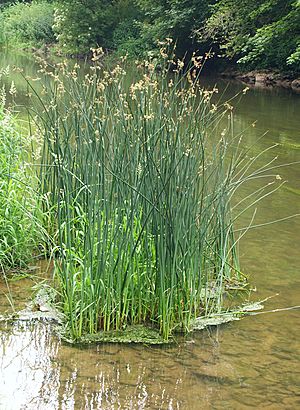Bulrush facts for kids
Bulrushes are tall, grass-like plants that grow in wet places like marshes and swamps. They are known by this common name, but they actually belong to different plant families. Most bulrushes are part of the sedge family.
Contents
Types of Bulrushes
The name "bulrush" is used for several groups of plants. It can be a bit confusing because different plants share this name.
Sedge Family Bulrushes
Many plants called bulrushes belong to the sedge family. Some important groups (genera) in this family include:
- Cyperus: This group includes the plant believed to be used in the famous Bible story of Moses.
- Scirpus: These plants are often called bulrushes in North America. Over time, some plants once in the Scirpus group have been moved to other related groups. These include Blysmus, Bolboschoenus, Scirpoides, Isolepis, Schoenoplectus, and Trichophorum.
Cattails (Typha)
Sometimes, the name "bulrush" is also used for plants in the Typha group. These plants are not in the sedge family; they belong to the Typhaceae family. In the United Kingdom, Typha species are often called reed mace. They are also commonly known as cattails because their flower heads look like a cat's tail.
Bulrushes in History
One of the most famous stories involving bulrushes comes from the Book of Exodus in the Bible. In this story, the baby Moses was placed in a small boat made from bulrushes. This boat was then hidden in the river. The plant used in this story was likely the paper reed (Cyperus papyrus).
Why Bulrushes Are Important
Bulrushes are very important for the environment, especially for fish. When fish lay their eggs, they often sweep away sand near bulrushes. This reveals the dense roots of the plants. These roots create excellent hiding spots and protection for young fish.
Related Plants
- Typha orientalis: This is a type of bulrush that grows year after year. It is found in places like Australia, New Zealand, and parts of Asia. It is a herbaceous plant, meaning it has soft stems rather than woody ones.


